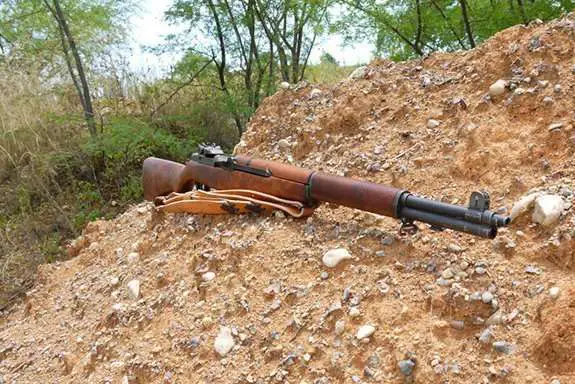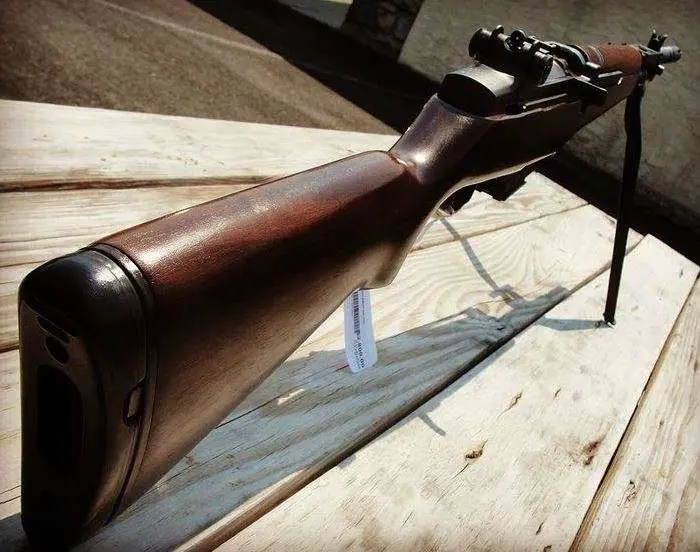
The .30″ caliber M1 Garand rifle was a gas-operated, semi-automatic, magazine-fed rifle that was developed by Springfield Armory firearms designer John Garand. The prototypes were refined during the 1920s and 1930s before being officially opted in 1932.
And even then, it did not formally enter service until 1936 through an executive decision by then-Army Chief of Staff General Douglas MacArthur.
The first production model was successfully proof-fired, function-fired, and fired for accuracy on July 21, 1937.
Springfield Armory produced modest quantities of the M1 Garand in the late 1930s and in ever-increasing numbers from 1940 to late 1945.
Following the outbreak of World War II in Europe, Winchester Repeating Arms Company of New Haven, Connecticut, was awarded a production contract. Winchester deliveries began in 1941 and ended in 1945.
The .30″ caliber M1 Garand rifle was relied on a Mannlicher-type system of clip-fed ammunition, inventor John Pedersen developed an “en bloc” clip system that allowed ammunition to be inserted from above, clip included, into the fixed magazine.
While this design provided the requisite flush-mount magazine, the clip system increased the rifle’s weight, and prevented it from being fired while changing magazines.
Garand’s M1 rifle was originally chambered for the .276 Pedersen (7 mm) cartridge, charged by means of 10-round clips. Later, it was chambered for the then-standard .30-06 Springfield. <– Ballistics info)
With this new cartridge, the Garand had a maximum effective range of 600 yards, with the capability of inflicting a casualty with armor-piercing ammunition well beyond 880 yards.
Because of the larger diameter of the .30-06 cartridge, the reworked magazine design held only eight rounds instead of ten.
The M1 Garand was the first semi-automatic rifle in the world to be issued to infantry. It officially replaced the Springfield M1903 rifle as the standard service rifle of the United States military in 1936, and was in turn replaced by the M14 (which was derived from the M1) in 1957.
The M1 was used heavily in World War II, the Korean War, and, to a limited extent, in the Vietnam War. Most M1 rifles were issued to American troops, though many were lent to other nations.
It is still used by various drill teams and is a popular civilian firearm.
The M1 Garand remains popular among civilian weapons collectors and enthusiasts all over the world.
General George S. Patton acknowledged the rifle’s prowess when he called it “the greatest implement of battle ever devised.”
Much of the M1 rifle inventory in the post-WWII period underwent arsenal repair or rebuilding. While U.S. forces were still engaged in the Korean War, the Department of Defense determined a need for additional production of the Garand, and two new contracts were awarded.
During the period of 1953 to 1956, M1 Garand rifles were produced by International Harvester at their Evansville, Indiana, facility and by Harrington & Richardson Arms Co. in Worcester, Massachusetts.
The Beretta firm in Italy also produced Garands using Winchester tooling called the BM 59.

Most recently, the M1 was produced by Springfield Armory, Inc. of Geneseo, Illinois, which is a commercial firm sharing the name of the military arsenal.
This commercial variant is offered in either .30-06 Springfield or the .308 Winchester chambering.
The M1 proved to be an excellent rifle throughout its service in World War II and the Korean War. The Japanese even developed a prototype copy for their own use near the end of World War II, but it never reached the production stage.
Some Garands were still being used in the Vietnam War in 1963; despite the M14’s official adoption in 1957, it was not until 1965 that the changeover from the M1 Garand was completed (with the exception of the sniper variants, which were introduced in WWII and saw action in Korea and Vietnam).
The original M1 Garand design used a rather unreliable gas system involving a special muzzle extension gas trap that was later dropped in favor of a simpler drilled gas port.
Because most of the older rifles were retrofitted, pre-1939 gas-trap Garands are very rare today and are prized collector’s items.
In both systems, expanding gases from a fired cartridge are diverted into the gas cylinder.
Here, the gases met a long-stroke piston attached to the operating rod. The operating rod was therefore pushed rearward by the force of this high-pressure gas.
Then, the operating rod engaged a rotating bolt inside the receiver.
The bolt was attached to the receiver via two locking lugs, which rotated, unlocked, and initiated the firing cycle when the rifle was discharged. The operating rod (and subsequently the bolt) then returned to its original position.
Conclusion:
The M1 Garand is an iconic American rifle that was just one of the many firearms used in war to bring peace. This rifle will continue to be a collector’s item for many years, as it should.
Read Next: M1 Carbine.
Check out our “rifles” page to learn more rifle history.

